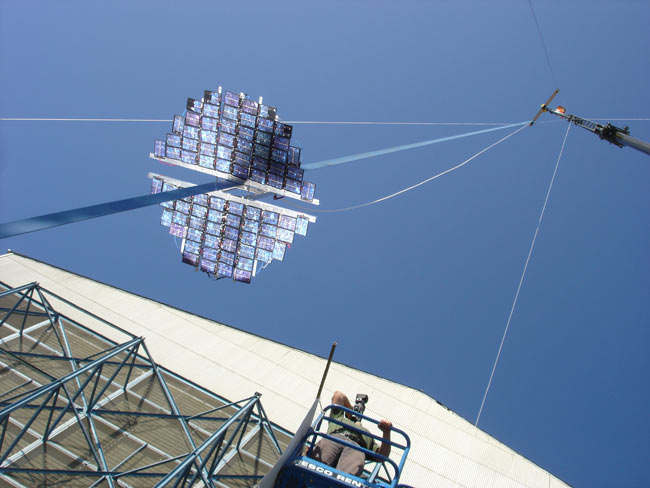Riding a Beam of Light: NASA's First Space Elevator Competition Proves Highly Challenging

MOUNTAINVIEW, Calif. - After three days of grueling competition and friendlyshoulder-to-shoulder innovation, over $100,000 in prize money remained in thevault at the close of the Space Elevator Games - the premier event of NASA'snew X-Prize-styled series of CentennialChallenges.
First envisionedin the 1960s, the spaceelevator concept began garnering serious attention with the discovery ofultra-strong carbonnanotubes. If built, space elevators wouldprovide an incredibly low-cost route for sending payloads, and eventuallyhumans, to Earth orbit and the universe beyond. NASA has funded studies of thespace elevator concept, which have given promising conclusions.
TwoEvents - Many Approaches
Designedto address the technical as well as "social engineering" issues ofthe space elevator, these twoengineering challenges are intended to generate interest and excitement inacademia, the space enthusiast community, and the general public.
The BeamPower Challenge tasks designers with building an unmanned machine, weighing 50to 100 pounds (22 to 45 kilograms), capable of pulling itself up a 4-inch(10-centimeter) wide, 200-foot (61-meter) long ribbon suspended from acrane, and powered only by the energy beamed up from a 10,000-Watt xenonsearchlight.
Seventeams vied for the $50,000 first prize, five from across the U.S. and two fromCanada.
TheUniversity of Saskatchewan team, led by Edwin Zhang, reached the highestaltitude under beamed power, about one third of the full distance. At thatpoint, their 10.7-square-foot (one-square meter) array of space-grade solarcells yielded insufficient energy to continue. Other entrants used varioussolar array schemes and even Stirling engines drivenby the searchlight's thermal energy.
Breaking space news, the latest updates on rocket launches, skywatching events and more!
In thesecond event, the Tether Challenge, four teams offered their best formulationfor an ultra-light, ultra-strong ribbon material. During one-on-onetug-of-wars, each of the entrants were tested to theirbreaking points.
In thefinal round, the strongest contender, fielded by CentaurusAerospace of Logan, Utah, yielded at 1,260 pounds of (571.5 kilograms) force,giving way to the "house ribbon" which broke at just over 1,300pounds (589.6 kilograms) of force, and leaving the $50,000 first prizeunclaimed.
GettingHigh on Engineering
"Clearlythese are hard problems," said Marc Schwager ofthe non-profit Spaceward Foundation, which manages the Space Elevator eventsfor NASA. "And getting the next generation of engineers inspired to solvethese problems will bring us untold benefits."
"Itis the pioneering spirit," said Spaceward's Falline Danforth. "Everybody pulling together to do something new. Wehaven't seen enough of that recently. It gives me a lot of hope for thefuture."
As inthe first year of the DARPAGrand Challenge for autonomous vehicles, the Space Elevator Challenges sethigh goals, and seek to inspire innovation as well as public attention.
"Thisyear's unclaimed prize money will be added to next year's, and that aloneshould boost the number of entrants," said Brant Sponberg,manager for NASA's Centennial Challenges program. "This is an excitingstart. We don't need to try to pick and choose which approaches might besuccessful. We simply invite all new ideas to come and give it a shot, and thenreward the best," he said.
With the2006 climber and tether challenge first prizes set at $150,000 each, and withsmaller awards for second and third places, over 20 teams have already signedup. Indeed, some of next year's hopefuls were seen in attendance, learning fromthis year's events and taking notes.
However, the 2006 rules includeadded challenges and requirement. "We're raising the bar technically, andwe will really need to stick to the time limits and all the rules for theentrants," said Schwager. "But all theteams I spoke said they'll be back!"
